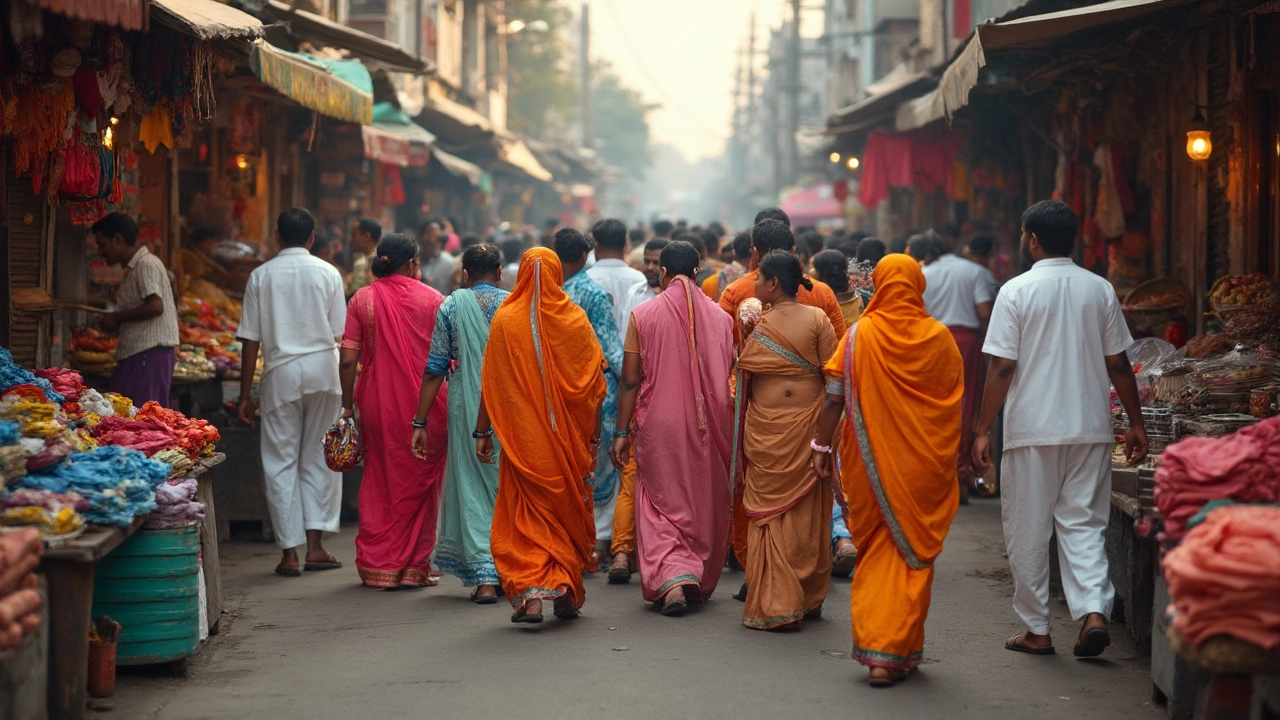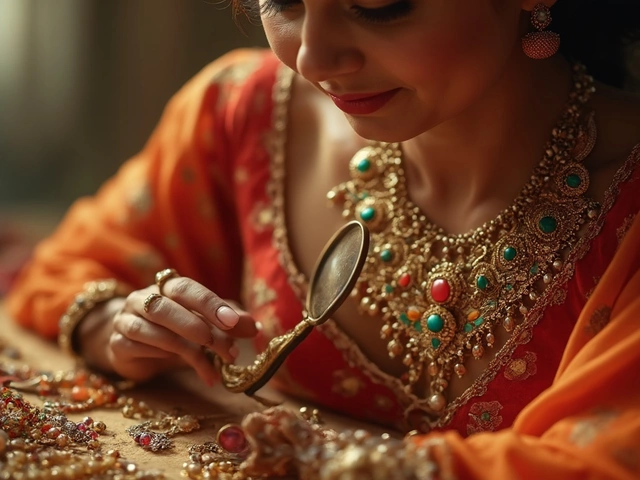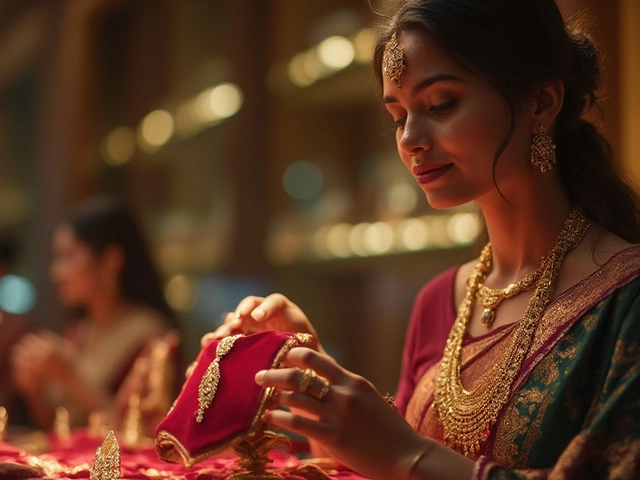
Ask anyone what clothing rules the streets in India, and you’ll get a different answer depending on where you are. You might spot someone headed to college in ripped jeans and a graphic tee, while the next person’s sashaying in a bright, embroidered kurta. The thing is, India doesn’t stick to just one dress code—its fashion blends old-school tradition with the latest global trends.
If you’re wondering what really flies off the shelves, it’s this mashup that stands out. Sarees and salwar suits are go-tos for women, especially for festivals and family functions, but don’t be surprised when you see sneakers paired with them. Guys reach for jeans, polos, and comfy cotton shirts, mixing it up with classic kurtas when needed. Accessories aren’t just add-ons—they’re non-negotiables. From beaded bangles to chunky jhumkas or sleek belts and crossbody bags, basics turn into head-turners real fast.
Thinking of shopping in India or revamping your closet with a few Indian touches? The best part is how easy it is to pick up practical, affordable pieces—think light dupattas to dress up a tee or fun silver earrings that match any vibe. It’s fashion that lets you blend in or stand out whenever you want.
- Everyday Essentials: The Most Common Outfits
- Traditional Styles Still Going Strong
- Western Wear’s Big Moment
- Accessories That Make an Impact
- Trendy Looks for Young Indians
- Shopping Tips & Where to Find Popular Looks
Everyday Essentials: The Most Common Outfits
If you land in any big Indian city, the first thing you’ll probably notice is the wild mix of styles. Let’s talk about the outfits you’ll see day after day, almost everywhere you go—from corner chai shops to tech offices.
For women, the salwar kameez snags the top spot, especially in northern and central parts of India. It’s basically a straight-cut or sometimes flared tunic (kameez) over relaxed trousers (salwar), usually paired with a long scarf or dupatta. This combo is practical, super comfy in humid weather, and easy to move around in. It’s not just for home—teachers, shop workers, and even lawyers rely on this staple. Cotton is the most popular material since it handles the heat better than synthetics.
Sarees are still a classic for many women, especially older generations, teachers, or for formal events. They’re less popular as an everyday choice for younger folks, but you’ll still spot them at offices or government buildings. Recent years have seen a twist—many young women now throw a denim jacket or sneakers into the mix for a high-low look.
When it comes to men, jeans and a T-shirt dominate across most cities, even in smaller towns. Polo shirts and button-downs get a lot of love too, especially with college students or white-collar workers. Kurtas, which are simple cotton tunics, hold their ground, especially on Fridays (many offices dub them traditional day) or for religious reasons.
Let’s break it down by numbers. A recent Nielsen India survey in 2024 showed these are the most common daily outfits among urban adults:
| Outfit Type | Women | Men |
|---|---|---|
| Salwar Kameez/Kurta | 58% | 22% |
| Saree | 15% | 0% |
| Jeans & T-shirt/Shirt | 19% | 56% |
| Western Dresses | 6% | 1% |
| Shorts/Track pants | 2% | 21% |
Younger people tend to lean more towards western wear, but traditional outfits never really go out of style. Office-goers often mix and match. Think: chinos with block-printed kurtas, or kurti tops with jeans. Even footwear is a mix—flip flops and sandals rule at home, while sneakers or loafers take over in public.
If you want to blend in, go for cotton or linen clothes in breathable cuts, slip on a kurta, or just pair your regular jeans with a locally bought scarf. Mixing things up is how most locals keep their wardrobe practical and fresh.
Traditional Styles Still Going Strong
Walk down any street during a festival or wedding season, and you'll see how traditional clothes still hold a special place in Indian closets. Sarees, salwar kameez, lehengas, and kurtas haven't gone out of style—they've just adapted. Everyone from students to office workers keeps at least one of these iconic outfits handy for family events, religious functions, or just a regular Friday at the office (yep, ethnic Fridays are a thing in most Indian workplaces).
The popular clothing India scene is shaped by how easily classic designs mix with comfort. The saree—often six yards of flowing fabric—isn’t just for grandmas. Women in big cities like Mumbai, Bangalore, and Delhi give it a modern spin by draping it with crop tops or even pairing it with sneakers. Men haven't ditched tradition either. The simple kurta, paired with jeans or pyjamas, is the go-to for both daily wear and big celebrations.
Here are some staples you’ll find in Indian wardrobes:
- Saree: Mostly cotton for summers, silk or georgette for functions. Around 50 million sarees are sold in India each year.
- Salwar Kameez: Popular in North India for its comfort and style. Tons of women prefer this set for everyday use.
- Kurtas: Worn by men and women, styles range from plain cotton for daily routines to brightly embroidered ones for festivals.
- Dhoti and Lungis: Classic menswear in rural and older communities, especially in South and East India.
You’ll notice regional flare too. Down south, Kanjeevaram sarees (silk, with heavy borders) are favorites for weddings. In Punjab, patiala salwars are all about comfort and movement. Even Bollywood celebrities often show up at award nights in lehengas or sherwanis, keeping these styles visible and desirable among young people.
The demand for traditional clothes rises sharply during key festivals. Here’s a quick look at how ethnic wear sales boost yearly during major events:
| Festival | Popular Traditional Wear | Estimated Sales Increase (%) |
|---|---|---|
| Diwali | Sarees, lehengas, kurta sets | 60-80% |
| Eid | Salwar suits, pathani kurta, shararas | 50-70% |
| Weddings (peak season) | Bridal sarees, sherwani, lehengas | Up to 100% |
| Pongal/Onam | Traditional silk sarees, mundu | 30-50% |
If you want to blend in during a family function or just score some compliments, you can’t go wrong with a simple kurta or a lightweight saree. They’re comfortable, and versatile, and say a lot about Indian heritage even as fashion keeps changing.
Western Wear’s Big Moment
Walk through any Indian city, and you’ll notice it’s not just about traditional clothes anymore. Western wear has totally taken off, especially with young people. Jeans, tee shirts, shirts, skirts, and even formal suits are regulars in Indian closets now. In fact, a 2024 survey by the Retailers Association of India showed that over 55% of Indian urban youth pick Western clothes for their daily outfits, and this number just keeps rising.
High streets and malls across the country are packed with global fast fashion brands. Local brands are also jumping in, offering cool versions of everything from denim jackets to jumpsuits. This shift isn’t just about copying the West—it’s about comfort, easy styling, and the ability to mix things up. Most workplaces, colleges, and even some festivals now see a solid mix of Western and Indian styles worn side by side.
Here’s why Western wear is such a hit in India right now:
- popular clothing India adapts easily: Tees and jeans work for college, cafés, or even casual office days.
- Easy to find: Every city has affordable local options right next to the big brands.
- Mix and match: People love pairing sneakers with kurtas, or a hoodie with a saree for a quirky twist.
- Weather-friendly: Cotton shirts, light jackets, shorts, and tank tops are a lifesaver in the Indian heat.
Women especially have way more choices now. From office-ready trousers to maxi dresses and denim skirts, Western pieces fit every type of routine. The rise of social media keeps these trends moving fast—new looks pop up every week on Instagram and Reels, and homegrown influencers make them go viral.
| Item | Most Popular Age Group | Where It’s Worn Most |
|---|---|---|
| Jeans | 15-30 | Across cities, colleges, casual outings |
| T-shirts | All ages | Homes, colleges, casual workspaces |
| Dresses/Skirts | 18-35 | Parties, offices, cafes |
| Formal Shirts/Suits | 25+ | Offices, business meetings |
If you’re in India and don’t want to stick out, grabbing a few pairs of jeans and tees is your best bet. They’re practical, blend in, and you won’t break the bank updating your look every season.

Accessories That Make an Impact
You can’t really talk about popular clothing India without giving a shoutout to accessories. In India, accessories do a lot more than just complete an outfit—they change how a whole look feels. For women, jhumkas (those cool, dangling earrings) and stacks of bangles can instantly take any kurta or saree to the next level. Bindis, those small dots worn on the forehead, are still common for special occasions and even for daily wear in some places.
Guys are catching up too. Watches, leather belts, chunky bracelets, and sunglasses are everywhere, especially with college students or young professionals. Even plain T-shirts and jeans look way sharper when paired with the right cap or a classic wristwatch. And don’t miss out on the backpacks and messenger bags slung across every other shoulder—practical but also picked for style.
A lot of these accessories aren’t just about fashion. They’re often picked for practical reasons or hold special meaning—like a mangalsutra necklace, which signals marriage, or a scarf tossed on to fight the sun and dust in big cities. Urban shoppers go for quick, trendy add-ons while traditional options still rule in small towns.
Here's a quick look at some stats showing what’s trending when it comes to accessories in India.
| Accessory | Popularity (2024 Survey) | Most Worn By |
|---|---|---|
| Jhumka Earrings | 78% | Women aged 18-40 |
| Wrist Watches | 55% | Men aged 16-35 |
| Scarves/Dupattas | 62% | Women across all ages |
| Messenger Bags | 48% | Urban youth |
| Bangles | 70% | Married women |
Want to make a real impression? Here are a few tips for nailing that accessory game in India:
- Lightweight jewelry goes a long way, especially with busy prints and bright clothes.
- Mixing metal bangles or bracelets with your watch gives an easy style boost.
- Handmade bags or embroidered clutches aren’t just pretty—they draw attention and can start conversations.
- Don’t skip sunglasses, especially if you plan to walk around in the afternoon.
- If you’re shopping local, check out craft markets for unique pieces at great prices.
Accessories in India aren’t just a small part of the outfit—sometimes, they’re what everyone remembers.
Trendy Looks for Young Indians
Walk through any college campus in India, and you’ll instantly see why fashion here changes as fast as Instagram trends. Today’s youth love to mix up popular clothing India basics with streetwear, ethnic touches, and whatever catches their favorite influencer’s eye.
Graphic tees with catchy slogans, ripped jeans, and oversized shirts are the top picks for guys. Girls usually rock crop tops, jumpsuits, high-waisted pants, or long skirts paired with short kurtis. Sneakers, slides, or comfy Kolhapuri chappals finish off most looks. And thanks to online shopping, kids in small towns can wear what’s hot in Mumbai or Delhi within days. It’s normal to match a western-style jacket with a traditional kurta or slip a pair of bright juttis under skinny jeans. Mixing and matching is the new normal.
The rise of K-pop, Korean dramas, and Bollywood stars sets the tone for fashion trends. Case in point: in 2024, searches for cargo pants and bucket hats shot up by over 60% in India, according to a report by a major e-commerce platform. Gen Z also cares about comfort and versatility—loose, breathable fabrics like cotton or linen, and easy-to-layer outfits are all the rage, especially in cities where summers get brutally hot.
Here are the top trends and essentials ruling Indian youth wardrobes right now:
- Oversized t-shirts and sweatshirts for that laid-back, all-day look
- Denim jackets and shackets (shirt-jacket hybrids)
- Cargo pants and joggers with lots of pockets
- Boho maxi dresses and flared palazzos paired with crop tops
- Traditional dupattas draped on western clothes for fusion style
- Chunky sneakers, sliders, and statement jewelry
Social media is a big deal. More than 70% of college students say they’ve bought clothes because of a social media trend or influencer, according to a 2024 youth lifestyle survey (see table below). Budget shopping apps like Myntra, Ajio, and Flipkart make it simple to follow these trends without going broke.
| Style/Trend | Popularity (%) |
|---|---|
| Oversized Tees/Sweats | 78 |
| Cargo Pants & Joggers | 65 |
| Fusion Outfits (Ethnic + Western) | 54 |
| Chunky Sneakers/Slides | 61 |
| Influencer-inspired Picks | 73 |
If you want to fit in but stand out at the same time, just follow the one simple rule: make it yours. Add a quirky bag, colorful bandana, or that one jacket everyone compliments. Indian youth don’t just follow trends—they shape them.
Shopping Tips & Where to Find Popular Looks
Finding popular clothing in India is a mix of knowing the best spots and keeping your eyes open for deals. Big cities like Delhi, Mumbai, and Bangalore are loaded with options, from street stalls to mega-malls. If you want to bag a great deal, head out early to local markets—think Sarojini Nagar in Delhi, Colaba Causeway in Mumbai, or Commercial Street in Bangalore. Street shopping means serious bargains, but you'll need to brush up on your haggling skills. Known brands and big chains like Pantaloons, W, FabIndia, and H&M are everywhere too, and their collections blend Indian and western styles without breaking the bank.
Online shopping is booming in India. Platforms like Myntra, Ajio, Amazon India, and Flipkart see millions of orders every month. You can easily filter by style, price, or size, and look for crazy deals during big sales—especially around Diwali or end-of-season clearances.
- Compare prices: Don’t jump on the first good-looking kurta or shirt. Check prices online, then offline, or vice versa. Major brands try to match online offers.
- Watch sizing: Indian brands sometimes use smaller sizing than Western ones. A large in Zara might feel tighter in a local brand, so check the charts before you buy.
- Check the return policy: Local markets almost never do returns, but stores and e-commerce sites have clear policies—use them if something doesn’t fit.
- Don’t ignore accessories: Markets have everything, from classic kolhapuri chappals (leather slippers) for ₹300 to quirky bags and chunky jewelry for under ₹500.
If you’re on the hunt for something unique, try small designer boutiques or pop-up exhibitions. Social media sellers on Instagram often stock cool, budget-friendly stuff you won’t find in stores.
| Shopping Spot | Type | Popular For |
|---|---|---|
| Sarojini Nagar (Delhi) | Market | Trendy, cheap street wear |
| Pandharpur (Maharashtra) | Local bazaar | Traditional dhotis, sarees |
| Commercial Street (Bangalore) | Market | Casual wear, accessories |
| Myntra | Online | Big sales, mixed brands/styles |
| FabIndia | Store & Online | Durable traditional wear |
| Instagram shops | Online | Trendy, unique accessories |
If you want to catch the latest dropping styles, follow Instagram or YouTube fashion influencers from India—they post about where to get what’s trending and which deals are real. And don’t stress if you’re new to the scene. Most locals are happy to share their favorite shopping tips if you simply ask.


